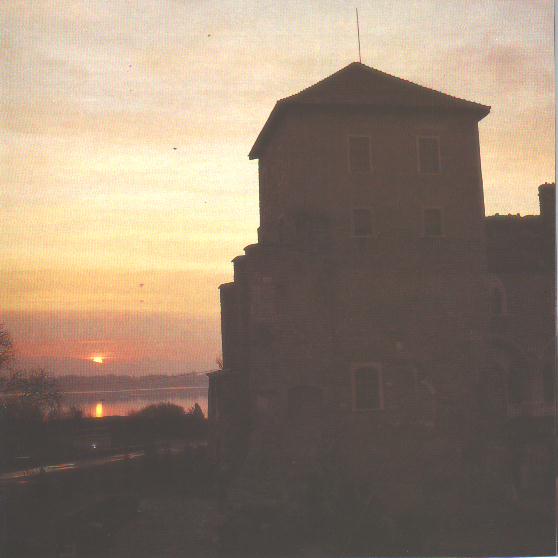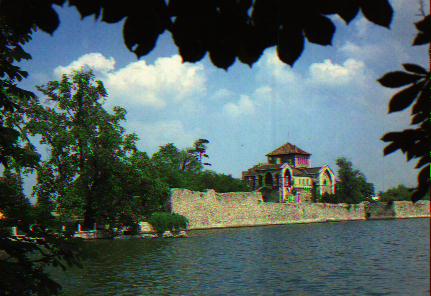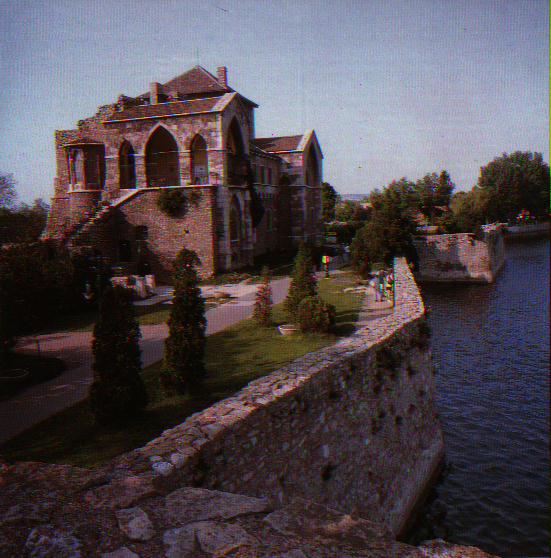 Fortress
Fortress 
 It is Lackfis who deserve credit for discovering the beauty of the location
and buliding the first fortress. The members of the family got close to
the power-in rank as well as geographically-in the Anjou kings' time. In
1392 they entertained their royal guest, Sigismund of Luxembourg here.
When Sigismund confiscated the Lackfis' property because of treason, he
only retained the land in Tata for himself, while distributing the rest
of their lands among his supporters. The buildings of his father, King
Charles IV, must have been in his mind, when Sigismund, Hungary's king
and emperor of the Holy Roman Empire developed the castle into a palace
that could meet any royal claim. In the second half of the 15th century
Mátyás Hunyadi converted it into a renaissance residence. According to
Bonfini at this time "there are heavily gilded dining halls, luxurious
bed chambers lining up in the building, the timber ceilings of the rooms
are decorated with rich gilding and carvings". Hardly three decades after
King Matthias, the conqueror of Vienna, died, one year after the Hungarians'
defeat at Mohács the garrison of the fortress killed seven of its officers
in order to submit to Ferdinand of Hapsburg.
It is Lackfis who deserve credit for discovering the beauty of the location
and buliding the first fortress. The members of the family got close to
the power-in rank as well as geographically-in the Anjou kings' time. In
1392 they entertained their royal guest, Sigismund of Luxembourg here.
When Sigismund confiscated the Lackfis' property because of treason, he
only retained the land in Tata for himself, while distributing the rest
of their lands among his supporters. The buildings of his father, King
Charles IV, must have been in his mind, when Sigismund, Hungary's king
and emperor of the Holy Roman Empire developed the castle into a palace
that could meet any royal claim. In the second half of the 15th century
Mátyás Hunyadi converted it into a renaissance residence. According to
Bonfini at this time "there are heavily gilded dining halls, luxurious
bed chambers lining up in the building, the timber ceilings of the rooms
are decorated with rich gilding and carvings". Hardly three decades after
King Matthias, the conqueror of Vienna, died, one year after the Hungarians'
defeat at Mohács the garrison of the fortress killed seven of its officers
in order to submit to Ferdinand of Hapsburg.
The
bastions of the fortress are the remains and witnesses of 150 years of
border battles.
In 1543, Hannibal Tasso, a mercenary captain enlisted in the defence of
the castle, had to pay with his head when he surrendered to the very first
summoning of the Turks.
 The one-time royal resting-place gradually became a real fortress.
By 1569, the southern fortifications, named after captain Ferrando Zamaria
Specie di Casa, had already existed. The last bastion was finished in 1586.
In 1558, the Turkish conquerors could celebrate a victory: captain János
Eszéki Nagy, joined by the garrison, left the castle in order to visit
some relatives in Komárom - and the Osmanli troops managed to occupy the
fortress without any effort. Among the Hungarian besiegers' leaders such
great names can be found as Transdanubia's captaingeneral Salm (1566),
Miklós Pálffy, the captain of Újvár's and Esztergom's castle (1597), and
in 1605, Gergely Némethy, the general of Hungary's Prince István Bocskay.
In 1620, Gábor Bethlen managed to occupy the castle, bt he had to renounce
his claim to it as well as to the other Transdanubian castles when concluding
the peace treaty in Nikolsburg.
The one-time royal resting-place gradually became a real fortress.
By 1569, the southern fortifications, named after captain Ferrando Zamaria
Specie di Casa, had already existed. The last bastion was finished in 1586.
In 1558, the Turkish conquerors could celebrate a victory: captain János
Eszéki Nagy, joined by the garrison, left the castle in order to visit
some relatives in Komárom - and the Osmanli troops managed to occupy the
fortress without any effort. Among the Hungarian besiegers' leaders such
great names can be found as Transdanubia's captaingeneral Salm (1566),
Miklós Pálffy, the captain of Újvár's and Esztergom's castle (1597), and
in 1605, Gergely Némethy, the general of Hungary's Prince István Bocskay.
In 1620, Gábor Bethlen managed to occupy the castle, bt he had to renounce
his claim to it as well as to the other Transdanubian castles when concluding
the peace treaty in Nikolsburg.
Dates, names, data... Victories and defeats... Fragments of Tata's history.




